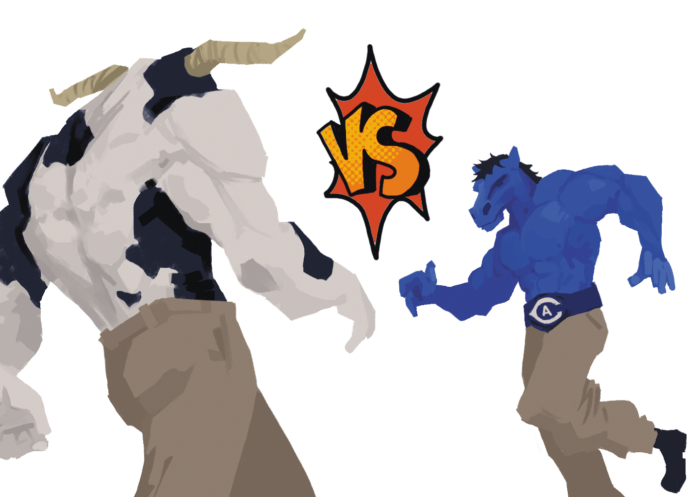UC Davis students discuss what image of UC Davis best represents the school and its history
By AMBER WARNKE — features@theaggie.org
The debate over whether or not the cow should replace Gunrock as the UC Davis mascot has been going on for years. In 2022, 73% of students voted to change the mascot to a cow in the spring elections for the ASUCD. However, concerns over how difficult re-branding would be, as well as what alumni would think, led to the choice to institute the cow as the ASUCD mascot, rather than as the UC Davis mascot. Nevertheless, the debate about which mascot would better represent the UC Davis community has lasted since this decision over two years ago.
Diego Tolliver, a third-year materials science and engineering major, weighed in.
“I think the cow is just a better representative of the spirit of the school in general,” Tolliver said. “Everything is cow-themed already. And the mustang is kind of a thing of the past.”
Tolliver proposed “Bucket” as a name for the potential cow mascot, and suggested that another reason the cow is the right mascot choice lies in how people often perceive UC Davis.
“I’ve heard of people kind of using ‘Davis as a cow school’ as a little bit of a derogatory thing,” Tolliver said. “But if we were to change our mascot to a cow, it would be kind of reclaiming that.”
Tolliver also pointed out that the cow mascot would suit Davis’ agriculture-heavy culture.
“I think it would be better to have a cow,” Tolliver said. “[Horses] are not as much of an agricultural thing as cows are, so that fits that a lot better.”
Jack Manly, a fourth-year history major, takes a very different approach to the issue.
“There is no such thing more agricultural than a horse,” Manly said. “It was horses that were used historically to till the fields, pull the plows, take farmers from one place to another. Horses have been an integral part of agriculture since we tamed them. I see no reason why we should switch to a cow.”
Manly went on to clarify the reasons behind his opinion.
“I think [Gunrock] then and still now represents the ideas of Davis as a campus and as a community,” Manly said. “I think it’s important also that we honor our history, which I feel strongly about as a history major.”
The real-life Gunrock was actually named Gun Rock and was a Thoroughbred, not a Mustang as the current mascot is. Gun Rock was born in 1914 to Rock Sand, the British Triple Crown Winner in 1903. He lived at UC Davis from 1921 to 1931, and while he did compete in races, Gun Rock did not land any significant wins. Instead, he was mainly considered valuable as a breeding horse. During his time at UC Davis, Gun Rock was bred with a whopping 476 mares, siring many notable racing horses.
Manly considered Gunrock a valuable symbol that represents UC Davis students.
“I think Gunrock represents the hardworking and motivated drive that all Aggies possess when it comes to academics,” Manly said. “Speaking from my personal opinion, I view horses as animals that have that drive, that motivation. Cows don’t evoke the same image. They evoke a wandering laziness, which is not what I believe that Davis currently represents, has represented in the past or will represent in the future.”
Manly also reflected on his experience as the Gunrock mascot at the 2024 Big West Conference basketball game.
“It’s hard to not feel connected when you are the embodiment of something, even if for a short period of time,” Manly said. “Being inside the Gunrock costume has only amplified that connection and passion I feel for it as a mascot.”
Grace Zuroff, a first-year graduate student at the School of Education, said she considers Gunrock to be unique from other university mascots.
“What other school has an anthropomorphic blue horse as their mascot who’s ripped AF?” Zuroff said.
She believes that Gunrock, standing apart from any other mascot, captures the spirit of UC Davis in a special way.
“It plays into the beauty of Davis in that we may not be like the biggest UC, but it’s still something that makes us fun and quirky,” Zuroff said.
Zuroff also acknowledged that having Gunrock represent UC Davis in athletics was more fitting than a cow, since cows don’t “really strike fear into other schools.”
However, one hangup she had about Gunrock was his representation in the infamous “Daddy Gunrock Senpai” fanfiction, which has been widely circulated on Instagram since 2021.
“The fan fiction and the fan art did not make me proud to be an Aggie,” Zuroff said. [That’s] one thing I want to be remembered by.”
Benton Buecker, a second-year environmental policy and planning major, also spoke to the way the mascot should represent UC Davis culture. However, he feels that cows better capture this spirit.
“Davis for the most part is this chill little college town where we have tons of access to nature,” Buecker said. “And I think that if we want to attract new students, I think that we should lean into the cow messaging.”
Buecker continued to describe the lack of connection between the student body and the current UC Davis mascot.
“I don’t think many people have any sort of emotional connection to Gunrock,” Buecker said.
Buecker believes that the merchandise already being more cow-focused points to the existing affection students have for cows over Gunrock and pointed out how other schools’ mascots represent their cultures more closely.
“You think of UC Santa Cruz, they’ve got the banana slugs, which I think is hilarious because it totally fits with their Redwood, laid-back vibe,” Beucker said. “And I think for Davis, we should have a mascot that represents our vibe and our campus, which I don’t think a blue horse does very well.”
He also criticized the need for mascots to be “hyper-masculine predator-type things,” believing that a cow might change that stereotype.
“The mascot should be a cow because, sorry, Gunrock, you’ve been dead for a hundred years,” Buecker said.
Manly stands in opposition to this viewpoint and wanted to make something clear.
“There is a room in the heart of the Aggies for both Gunrock and the cow,” Manly said.
“There is room for both in this ecosystem.”
Written by: Amber Warnke — features@theaggie.org





